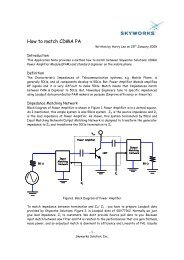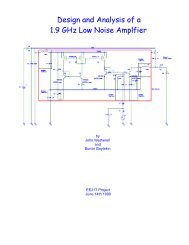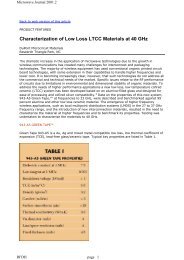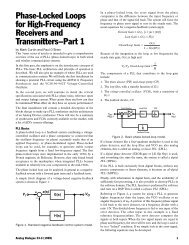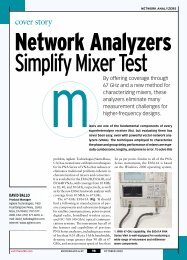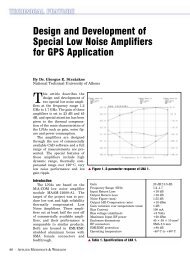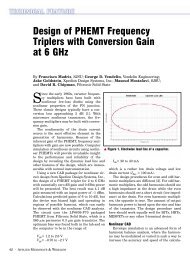Surface Mount Components Reduce Broadband Equipment Costs
Surface Mount Components Reduce Broadband Equipment Costs
Surface Mount Components Reduce Broadband Equipment Costs
You also want an ePaper? Increase the reach of your titles
YUMPU automatically turns print PDFs into web optimized ePapers that Google loves.
<strong>Surface</strong> <strong>Mount</strong> <strong>Components</strong><br />
<strong>Reduce</strong> <strong>Broadband</strong><br />
<strong>Equipment</strong> <strong>Costs</strong><br />
By John Kennedy<br />
Alpha Industries<br />
Manufacturing throughput and costs are<br />
becoming critical as microwave radio<br />
manufacturers ramp up production to<br />
meet the growing demand for high-frequency,<br />
high-speed broadband communications. Alpha’s<br />
DC to 43 GHz surface mount components simplify<br />
production processes while improving<br />
manufacturing yields.<br />
Manufacturers of point-to-point microwave<br />
and high-speed optical communications systems<br />
are scaling up production because of the growing<br />
demand for metropolitan networks, first/last<br />
mile access, ring closure and cellular base station<br />
interconnection. At the same time, they are<br />
looking for ways to reduce manufacturing costs.<br />
In addition, market demand is outstripping the<br />
production capacity of many microwave and<br />
fiber optic equipment manufacturers, which<br />
opens the door to increased competition from<br />
T1, DSL and other low-frequency data delivery<br />
systems.<br />
Microwave and fiber optic equipment manufacturers<br />
can no longer rely on traditional production<br />
systems and methods to maintain market<br />
share and keep pace with growing demand.<br />
Many manufacturers are finding it difficult to<br />
ramp up production using conventional “chipand-wire”<br />
component assembly, a process that<br />
requires vacuum pickups and other expensive<br />
capital equipment, as well as highly-trained and<br />
skilled assembly technicians, who are currently<br />
in short supply. The Alpha-2 TM program helps<br />
manufacturers address these problems.<br />
The Alpha solution<br />
Alpha’s design objective is to allow high-frequency,<br />
high-speed broadband communications<br />
manufacturers to reduce their production costs<br />
Gain (dB)<br />
25<br />
20<br />
15<br />
10<br />
5<br />
MMIC on Wafer<br />
MMIC in A2 Package<br />
0<br />
24 26 28 30<br />
Frequency (GHz)<br />
▲ Figure 1. Electrical characteristics of Alpha-2 TM<br />
packaged components maintain the performance<br />
of bare MMICs.<br />
while addressing the interface, grounding and<br />
quality control problems often encountered<br />
when incorporating high-frequency MMICs into<br />
microwave transceivers and fiber optic equipment.<br />
Alpha’s proprietary surface mount technology<br />
is now implemented in an extendable multichip<br />
module family of low-noise amplifiers, driver<br />
amplifiers, variable attenuators and mixers<br />
designed to operate at frequencies of up to 43<br />
GHz. These multi-chip, ceramic packages significantly<br />
reduce the manufacturing cost of LMDS<br />
and fiber optic networking equipment.<br />
The Alpha-2 program provides the necessary,<br />
single-step solution. It addresses the manufacturing<br />
and quality control problems facing<br />
microwave and fiber optic equipment manufacturers<br />
and meets industry demands for highly<br />
102 · APPLIED MICROWAVE & WIRELESS
(dB)<br />
0<br />
-10<br />
-20<br />
-30<br />
-40<br />
-50<br />
-60<br />
A2 short-circuit Shorted isolation<br />
-70<br />
A2 open-circuit Open isolation<br />
-80<br />
0 10 20 30 40<br />
Frequency (GHz)<br />
A2Sh t dSP t<br />
▲ Figure 2. The Alpha-2 package maintains high isolation<br />
through 43 GHz, eliminating feedback-induced ripple.<br />
RF In<br />
DC Connections<br />
DC Connections<br />
64 Via Holes<br />
RF Out<br />
▲ Figure 3. The Alpha-2 footprint, patterned on a printed<br />
circuit board, facilitates either microstrip or coplanar<br />
waveguide connections.<br />
reliable components operating at frequencies up to 43<br />
GHz. Alpha-2 is the first surface-mounted package<br />
specifically designed for high-frequency, high-speed ICs<br />
used to implement point-to-point microwave links, Local<br />
Multipoint Distribution Systems (LMDS) and OC-<br />
192/OC-768 fiber optic systems. The Alpha-2 family currently<br />
includes low-noise amplifiers, driver amplifiers,<br />
single- and double-balanced mixers and variable attenuators,<br />
and an SPDT switch will be released shortly.<br />
Electrical signals operating at millimeterwave frequencies,<br />
if not constrained, radiate in all directions,<br />
causing a loss proportional to the wavelength of the signal.<br />
Plastic packaging can not control this loss and can<br />
not control radiated feedback that can distort the original<br />
signal. Alpha has addressed this problem with<br />
ceramic packaging. The Alpha-2 package encloses the<br />
microwave circuit in such a way that the electromagnetic<br />
signal can propagate within the package in a controlled<br />
manner. The Alpha-2 package also provides a<br />
method for transferring a signal from the microwave circuit<br />
to the printed circuit board. The base of the package<br />
is made from a dielectric ceramic material over which a<br />
conductive layer is placed to form a transmission line<br />
with carefully controlled impedance. This transmission<br />
line forms an electromagnetic wave guide that, combined<br />
with the desirable electrical properties of the<br />
ceramic package, minimizes signal loss. As a result, the<br />
electrical characteristics of Alpha-2 packaged components<br />
are virtually identical to MMICs, as shown in<br />
Figure 1. They provide >40 dB isolation (Figure 2) with<br />
only a few tenths of a dB loss. Alpha-2 ceramic components<br />
also have good mechanical properties because they<br />
can be formed with the precise, smooth surface needed<br />
for high-definition patterns. At the same time, ceramics<br />
tolerate temperature extremes and exhibit a thermal<br />
coefficient of expansion nearly matching that of the gallium<br />
arsenide commonly used for MMICs.<br />
0.204<br />
(5.18 mm)<br />
0.194<br />
(4.93 mm)<br />
0.251<br />
(6.38 mm)<br />
0.056<br />
(1.42 mm)<br />
2X 0.044<br />
(1.12 mm)<br />
0.016<br />
(0.41 mm)<br />
0.241<br />
(6.12 mm)<br />
8X 0.020<br />
(0.51 mm)<br />
2X 0.129<br />
(3.28 mm)<br />
0.040<br />
(1.02 mm)<br />
Environmental and mechanical dependability<br />
Alpha-2 products have outstanding mechanical specifications<br />
and are designed for standard, inexpensive,<br />
reflow solder, surface mounting and are compatible with<br />
standard tape and reel equipment. In essence, Alpha-2<br />
components are handled and are assembled like low-frequency,<br />
baseband components.<br />
Ceramic packaging is ideal for transceivers and other<br />
components that must operate on open rooftops and<br />
other exposed environments where they may be subjected<br />
to high humidity and extreme temperatures. Building<br />
on its experience with ceramics, Alpha was able to develop<br />
a family of high-frequency surface mount components<br />
capable of operating in military temperature<br />
ranges of –55 degrees to +90 degrees C with sealed components<br />
that pass standard moisture intrusion tests (85<br />
C L<br />
2X 0.064<br />
(1.63 mm)<br />
2X 0.085<br />
(2.16 mm)<br />
C L<br />
2X 0.043<br />
(1.09 mm)<br />
▲ Figure 4. Alpha-2 outline occupies only 0.05 square inches<br />
of board space and is just 0.06 inches tall.<br />
104 · APPLIED MICROWAVE & WIRELESS
systems and the elimination of expensive reworks.<br />
Unlike MMICs that are tested on the wafer, Alpha-2<br />
products are tested after packaging when they are<br />
immune to damage in handling. This method saves costly<br />
reworks that can slow production and increase the<br />
manufacturer’s total cost of ownership.<br />
▲ Figure 5. Alpha-2 components are delivered on tape-andreel<br />
for direct insertion in high-volume manufacturing<br />
lines.<br />
percent relative humidity for 1,000 hours).<br />
Figure 4 shows the Alpha-2 footprint with numerous<br />
via holes to provide positive grounding. Each via is filled<br />
with a conductive material and the vias both direct the<br />
signal from the package to the microwave circuit and<br />
block propagation of the signal to prevent feedback to<br />
the microwave circuit.<br />
Eliminating reworks<br />
MMICs are small, fragile, difficult to handle and easy<br />
to damage. <strong>Components</strong> that passed quality control tests<br />
at the wafer level may no longer operate properly after<br />
they have been sawed and handled. As a result, transceivers<br />
often have to be reworked, adding substantially<br />
to manufacturing costs. Such existing transceiver manufacturing<br />
processes present inherent quality control<br />
problems. As manufacturers of cellular phones and PCs<br />
have shown, the elimination of “bare” chips is a prerequisite<br />
in the development of high-volume manufacturing<br />
6<br />
Lowering manufacturing costs<br />
Integrated circuits for microwave and millimeterwave<br />
applications have traditionally been wired together in<br />
large, expensive, hard to assemble packages. The cost of<br />
this packaging is often many times the cost of the chips<br />
themselves. Alpha-2 packaging solves this problem. By<br />
eliminating the need for tuning and the slow, expensive<br />
process of wire bonding by hand, Alpha-2 technology<br />
enables manufacturers of high-frequency broadband<br />
equipment to replace labor and capital intensive microelectronics<br />
assembly with standard, fast, inexpensive<br />
surface-mount manufacturing. This is particularly<br />
important to manufacturers attempting to ramp up production<br />
in the face of a growing shortage of highly<br />
skilled wire-bond technicians.<br />
Alpha has made available a number of different components<br />
in low-cost Alpha-2 packages. For example, the<br />
AA028P2-A2, a 25 to 31 GHz driver, is only $7.74 in<br />
quantities of 100,000.<br />
Solution example<br />
Alpha’s offering of different Alpha-2 components<br />
allows implementation of complete broadband transceivers<br />
in a single assembly technology. Alpha is continuing<br />
to expand our product line to cover more frequencies<br />
and more functions.<br />
Alpha has developed designs that show how standard<br />
Alpha-2 components fit into common broadband applications<br />
to help manufacturers to transition to the use of<br />
Alpha-2 components. One such<br />
design, a 28 GHz wireless<br />
broadband transceiver, is<br />
shown in Figure 6. This design,<br />
which has been successfully<br />
prototyped, represents one of<br />
the first all-surface-mount<br />
broadband transceiver designs<br />
at this frequency.<br />
7<br />
▲ Figure 6. A high frequency wireless broadband transceiver consists of ten Alpha-2<br />
components that can be mounted to a printed circuit board in a single operation. The<br />
total semiconductor cost is less than $100.<br />
The next generation<br />
The current generation of<br />
high-frequency communications<br />
transceivers will likely be<br />
obsolete in a year or two as<br />
manufacturers develop new<br />
high frequency, high data rate<br />
broadband communication systems<br />
operating up to 60 GHz<br />
and data rates up to 40 Gbps.<br />
106 · APPLIED MICROWAVE & WIRELESS
At the same time, the growing demand for broadband<br />
communication devices will force manufacturers to<br />
streamline manufacturing processes. Alpha is developing<br />
the products needed to support the next generation<br />
of microwave and fiber optic systems while reducing<br />
manufacturing costs.<br />
The Alpha-2 family joins Alpha’s line of RF,<br />
microwave and millimeterwave GaAs ICs, discrete semiconductor<br />
devices and passive components engineered<br />
for wireless telephony and satellite, instrumentation,<br />
defense and other communications markets.<br />
Manufacturers today are not just buying new parts,<br />
they are looking to work with a company that will work<br />
with them to develop new and better products and<br />
processes that will allow them to capitalize on the growing<br />
demand for high-speed, high-capacity voice and data<br />
transmission.<br />
Working with leading microwave and fiber optic<br />
equipment manufacturers, Alpha is creating the innovative<br />
new products needed to support the ever-growing<br />
volume of broadband traffic. Alpha has demonstrated its<br />
ability to integrate multiple components in ever-smaller<br />
packages. And, with its proven high-volume, low-cost<br />
production capabilities, Alpha is providing its customers<br />
with the innovative products they need to meet the<br />
growing demand for ultra-high speed, high-capacity data<br />
and voice wireless communications.<br />
■<br />
Author information<br />
John Kennedy is an engineering manager at Alpha<br />
Industries. He received his BSEE and MSEE from the<br />
University of Massachusetts and his MBA from<br />
Syracuse University. He has been working in high-frequency<br />
packaging for fifteen years. He may be reached<br />
by e-mail at jkennedy@alphaind.com<br />
For more information, contact:<br />
Alpha Industries<br />
20 Sylvan Road<br />
Woburn, MA 001801<br />
Tel: 781-935-5150<br />
Fax: 617-824-4579<br />
E-mail: sales@alphaind.com<br />
Internet: www.alphaind.com<br />
or circle Reader Service #200<br />
108 · APPLIED MICROWAVE & WIRELESS






